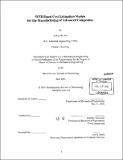| dc.contributor.advisor | Timothy Gutowski. | en_US |
| dc.contributor.author | Pas, Joshua W. (Joshua Wasawit), 1977- | en_US |
| dc.contributor.other | Massachusetts Institute of Technology. Dept. of Mechanical Engineering. | en_US |
| dc.date.accessioned | 2005-08-23T21:15:23Z | |
| dc.date.available | 2005-08-23T21:15:23Z | |
| dc.date.copyright | 2001 | en_US |
| dc.date.issued | 2001 | en_US |
| dc.identifier.uri | http://hdl.handle.net/1721.1/8558 | |
| dc.description | Thesis (S.M.)--Massachusetts Institute of Technology, Dept. of Mechanical Engineering, 2001. | en_US |
| dc.description | Includes bibliographical references (p. 124-125). | en_US |
| dc.description.abstract | Presently there are many cost estimation methods and software available to the public for metal processing, but there are almost none (excluding proprietary) for advanced composites. As a result, our research group's objective has been to create Cost Estimation Models (CEMs) for the advanced composites. This thesis focuses on the modeling of the parts and processes as well as the implementation of the CEMs. With funding from the National Science Foundation (NSF), accessibility of the desired CEM deliverables to the public domain was paramount; therefore, the Internet technology has been used as our basic tool. The CEM is a process-based cost estimation model using the first order dynamic law. The time constant, extensive velocity, equations and other parameters are based upon the work of [Neoh]. The goals of the CEM are to give the time and cost estimations as well as to assist the designer in evaluating the cost reduction strategies. Because the CEM also facilitates in production volume and process decisions, the CEM user can easily make comparisons in order to make the best implementation choices that will subsequently yield the relative optimal results. Fourteen shapes have been modeled with five processes (Automated Tow Placement, Forming, Hand Layup, Pultrusion, and Resin Transfer Molding). The CEMs are developed for both novice and expert users by providing default values that can be modified. The expert user can easily overwrite the default values and modify the process plan. All calculations for the models use JavaScript which has been embedded into the HTML interface. XML databases have been implemented into the CEMs to store the parameters from previous work for the process, materials, and resources. In future updates of the models, the programmer will only need to update the database without needing to make any changes in the JavaScript coding. A number of beneficial tools have been included in the models to assist the CEM user along every step. Finally, the CEMs have been tested with very satisfactory results. The CEMs are published to [as of 7 Feb. 2017, link is broken].http://web.mit.edu/mp/www/composites/costmodel/ | en_US |
| dc.description.statementofresponsibility | by Joshua W. Pas. | en_US |
| dc.format.extent | 125 p. | en_US |
| dc.format.extent | 10760083 bytes | |
| dc.format.extent | 10759841 bytes | |
| dc.format.mimetype | application/pdf | |
| dc.format.mimetype | application/pdf | |
| dc.language.iso | eng | en_US |
| dc.publisher | Massachusetts Institute of Technology | en_US |
| dc.rights | M.I.T. theses are protected by copyright. They may be viewed from this source for any purpose, but reproduction or distribution in any format is prohibited without written permission. See provided URL for inquiries about permission. | en_US |
| dc.rights.uri | http://dspace.mit.edu/handle/1721.1/7582 | |
| dc.subject | Mechanical Engineering. | en_US |
| dc.title | WEB based cost estimation models for the manufacturing of advanced composites | en_US |
| dc.type | Thesis | en_US |
| dc.description.degree | S.M. | en_US |
| dc.contributor.department | Massachusetts Institute of Technology. Department of Mechanical Engineering | |
| dc.identifier.oclc | 49039028 | en_US |
